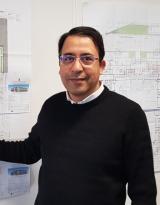“Teamwork is an important factor in the success of this type of project”
Hassan Mirdas, Head of Building & Infrastructures – BV France
What was your role in this project?
It was a Project Management role, among other things. A team of about ten people worked on this project, in the context of the various tasks that were entrusted to us by the client (the FTF). As such, I attended various sites and review meetings; I was also the link between my specialist colleagues and external providers dealing with subjects in the same specialities.
My role was also to be an interface with the client, to meet their expectations, to adjust certain contract details as the project evolved.
The role also covered technical support in my field of expertise, mainly with regard to the structure (metal and reinforced concrete).
What was the most interesting part for you?
There were many, but I can mention a few:
- Given the geometry of the cover, it wasn't possible to fully assess the effects of wind on the central court using just calculations. Wind tunnel tests were therefore carried out at the CSTB in Nantes to simulate the effects of wind on the building and to determine the resulting stresses.
- The roof weighed nearly 3,500 tons and, in the retracted position, rests mainly on two pairs of columns which, in the vocabulary of the project, were called "slender columns". A pair of columns on each side of the building. They are "fine" posts, 25 m in height, and their calculations are simple in theory, but given the challenges related to this very important role, the surveys were as comprehensive as possible, including considering an accident with a column.
- The current clay on the central court is the surface that has always been there. It was necessary to protect it, but above all, to adapt the technical choices to build one of the grandstands based on this limitation!
- The sections that make up the roof are flexible in terms of their range, up to more than 100 m, a damping device became necessary, and the tests carried out showed the behaviour was consistent with the results of the studies.
What did you learn during this project?
Teamwork is an important factor in the success of this type of project. Especially when team members integrate all the challenges of the project and reflect a shared sense of responsibility to the other participants, including the client. This confirms what we have seen in other similar projects?
This helped us to build good relations with the French Federation of Tennis (FFT).
What problems did you encounter and how did you solve them?
There were many technical problems, and they often gave rise to technical meetings. For the most important ones, most of the time our opinions were issued on the basis of calculations or tests.
How would you sum up this project in one sentence?
It was an exceptional adventure.
It’s not a building, but rather a work of art given the loads in question, the spans and the tonnages or volumes of materials used. The timelines related to the nature of the site itself, namely the stadium hosting the RG tournament each year, the working timelines were reduced to 10 months per year, leaving 2 months for the organisation of tournaments.
